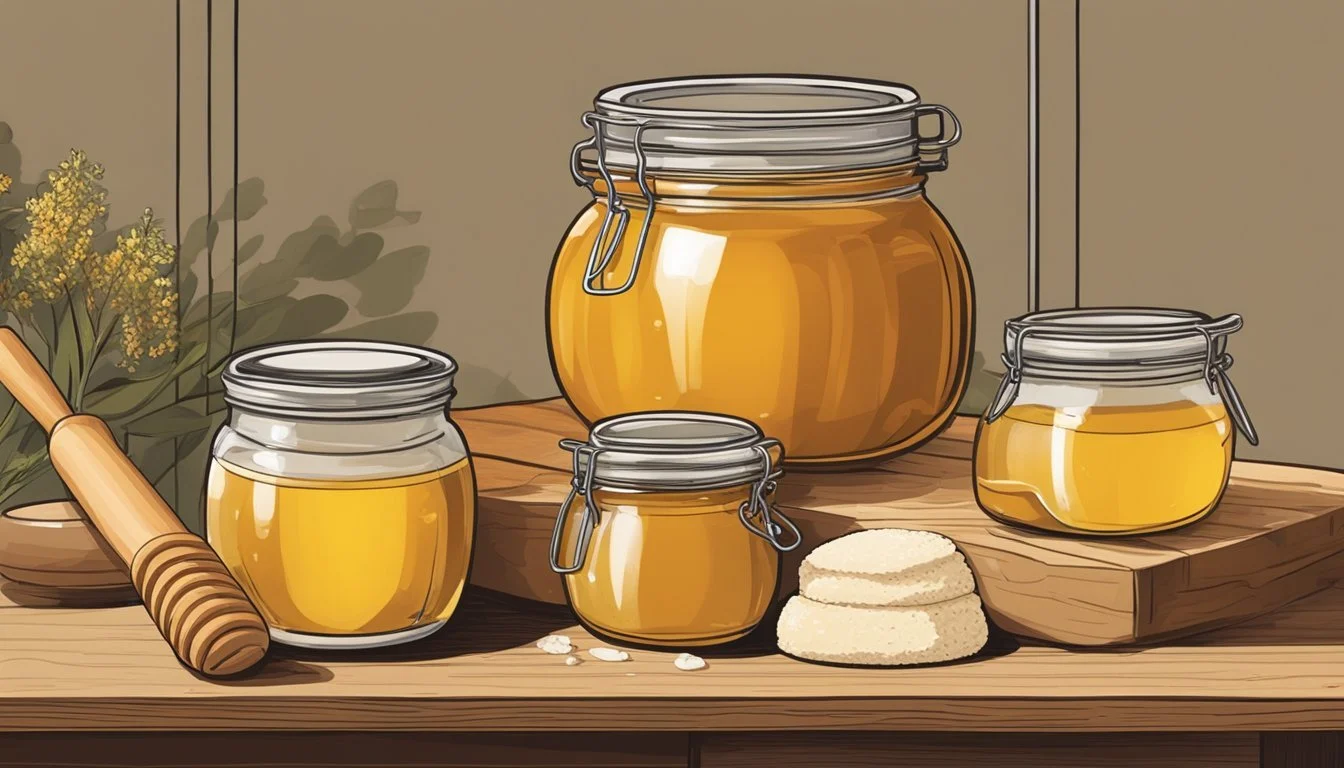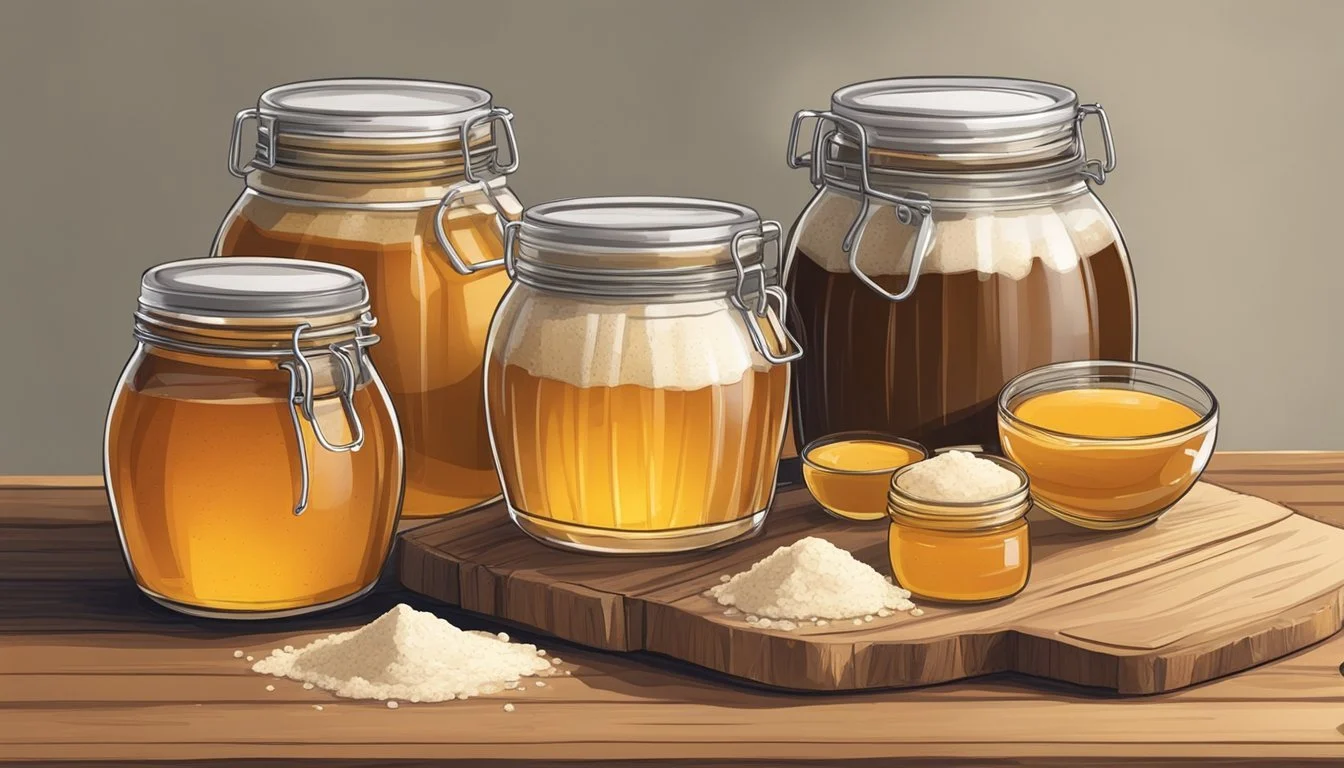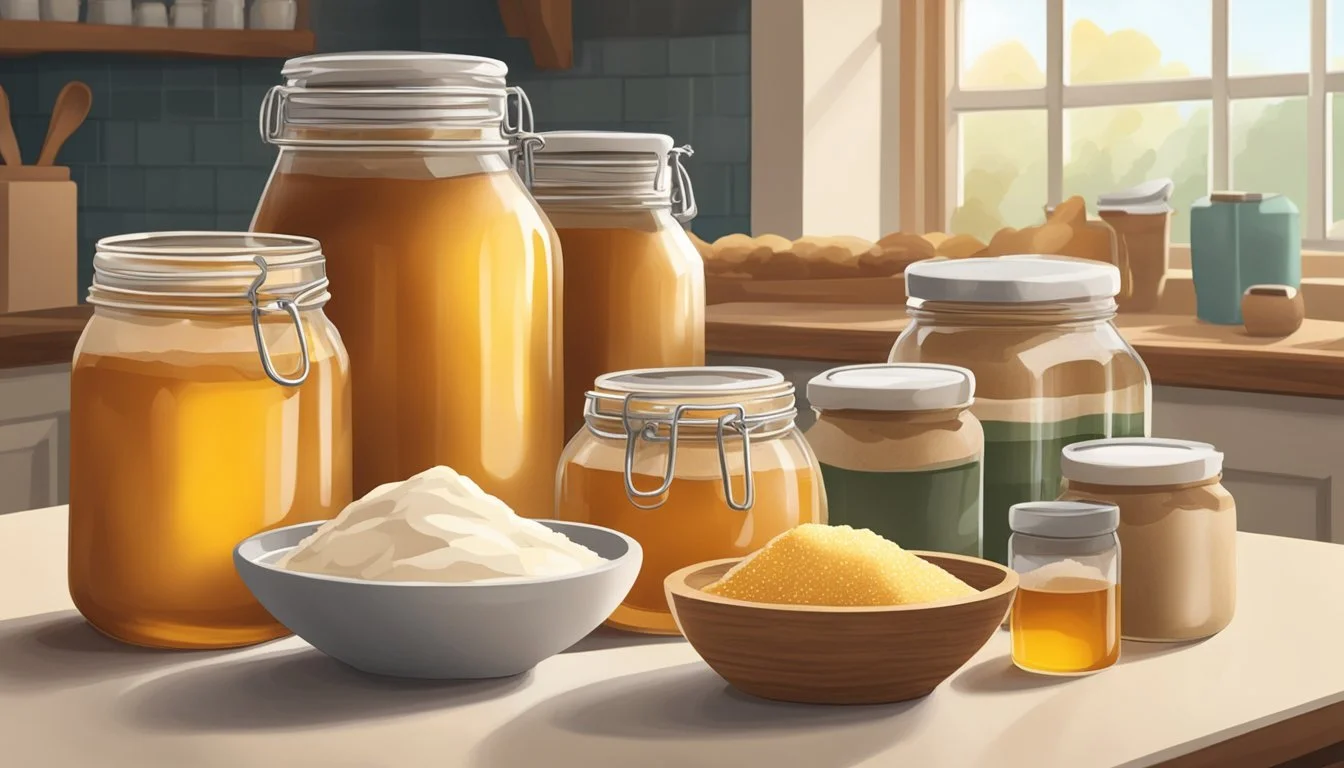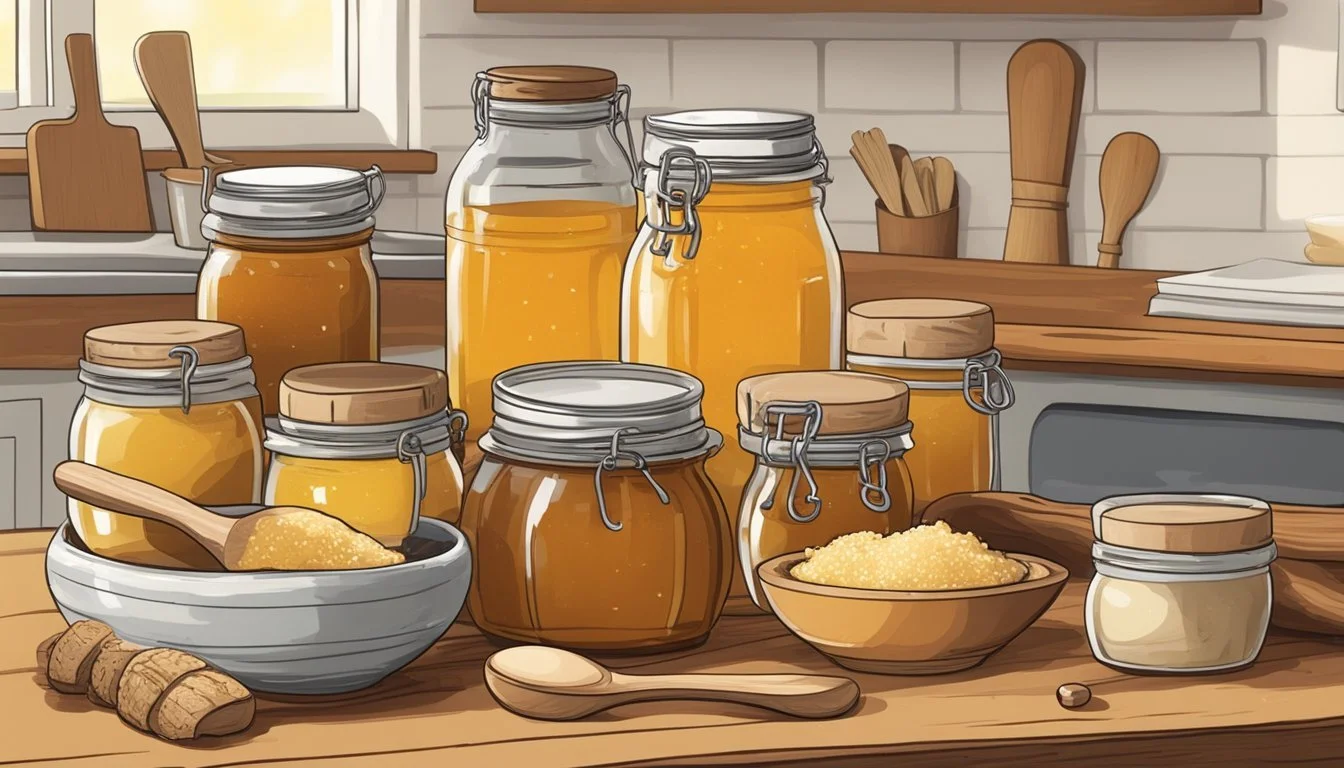Sourdough Baking with Alternative Sugars
Exploring Honey, Maple, and Natural Sweeteners
Sourdough baking is a traditional method that relies on the intricate balance of natural yeast and beneficial bacteria within a sourdough starter to ferment dough and impart a distinctive flavor. This fermentation process, central to creating sourdough bread's (What wine goes well with bread?) characteristic tang and texture, can be influenced by various types of sweeteners. These alternative sugars not only serve as an additional source of food for the microscopic workers in the starter but also contribute unique flavors and characteristics to the finished loaf.
Incorporating sweeteners like honey, maple syrup, and other non-traditional sugars into sourdough recipes can yield several advantages. Honey, for example, is a natural humectant that can help to keep bread moist, soften its crumb, and offer a mild sweetness that can balance the inherent sourness of the bread. Similarly, maple syrup provides a subtle complexity with its rich, woodsy notes, potentially enhancing the overall flavor profile. When utilizing alternative sugars, one must consider how they may alter the fermentation process, as different sugars can affect the growth rate of yeast and bacteria in various ways.
As bakers explore the use of alternative sugars in sourdough, it's important to understand the science behind these choices. Each sweetener interacts with the sourdough starter and dough differently, influencing not only the taste but also the browning of the crust and the texture of the crumb. While traditional white sugar is primarily used for its fermentable properties, alternative sugars bring a spectrum of flavors, colors, and textures, adding new dimensions to the age-old art of sourdough baking.
The Basics of Sourdough Baking
Sourdough baking must consider the complex interactions of ingredients and time. The mastery of these elements is crucial for creating the perfect loaf.
Understanding Sourdough Starter and Fermentation
A sourdough starter is a culture of wild yeast and bacteria in a mixture of flour and water. Over time, this culture ferments, creating an environment where yeast thrives and produces the carbon dioxide necessary for dough leavening. The starter's microbial activity is influenced by temperature and feeding frequency, involving regular discards and replenishments with fresh flour and water.
The Role of Flour and Water in Sourdough
Flour provides the starches and proteins, like gluten, that yeast feeds on and gives structure to the dough. High-protein flours can create a stronger gluten network, which is essential for trapping gases during fermentation. Water starts the hydration process, affects the dough's temperature, and influences gluten development. The type and temperature of the water can impact the sourdough's overall texture and flavor.
Hydration Ratios and Dough Structure
Hydration ratios, the proportion of water to flour, are critical in sourdough recipes. Hydration affects the dough's handling, fermentation rate, and crumb structure. Higher hydration typically leads to a more open crumb with larger air pockets, while lower hydration results in a denser, more manageable dough. Precise ratio adjustments can tailor the bread's texture to a baker's preference.
Art of the Sourdough Process
Sourdough baking is an art involving precise techniques like autolyse, an initial rest period for the dough before adding salt, which allows for better gluten formation and hydration. Bulk fermentation is a long, slow rise that develops flavor. It often includes stretch and folds, periodic gentle manipulations of the dough to strengthen gluten and distribute temperature without deflating the dough. Each step, from mixing to baking, is essential in crafting a flavorful, well-structured sourdough loaf.
Integrating Alternative Sugars in Sourdough Baking
Incorporating non-traditional sweeteners into sourdough recipes can enhance both flavor and texture. This section will explore how different sugars affect sourdough bread and offer guidance on choosing and using these alternatives effectively.
Effects of Different Sugars on Sourdough Bread
Maple Syrup: Its natural sugars primarily consist of sucrose, with smaller amounts of fructose and glucose. Maple syrup can lead to a subtly sweet flavor and can contribute to the browning of the crust due to its sugars caramelizing at high temperatures.
Honey (What wine goes well with honey?): Known for its enzymes, vitamins, and mix of glucose and fructose, honey is not only a sweetener but also a flavor enhancer. In sourdough, it provides immediate food for yeast, potentially accelerating the fermentation process.
Agave Nectar: Agave is higher in fructose compared to glucose, leading to a lower glycemic index. It adds moistness and a distinct flavor and can influence the fermentation rate due to its high fructose content.
Molasses: This byproduct of sugar refining contains both glucose and fructose. It imparts a robust flavor, darker crumb, and contributes to the browning of the crust. Its complex sugar composition may alter the rate of fermentation.
Why Choose Alternative Sweeteners?
Flavor: Alternatives like maple syrup, honey, and molasses offer unique flavors absent from white sugar.
Texture: These sweeteners can affect crumb softness and crust crispness as a result of their varying hygroscopic (water-attracting) properties.
Nutritional Profile: They often contain trace minerals and vitamins not found in granulated sugar.
Natural Sweeteners vs. Granulated Sugar
Granulated Sugar (Sucrose): Standard in baking, it provides sweetness and structure but lacks additional flavors.
Natural Sweeteners: These can vary in their glucose and fructose content, influencing sweetness levels, fermentation rates, and nutritional benefits. They often enhance the bread's flavor complexity and can alter the texture.
Maple, Honey, Agave: A Comparative Analysis
Maple Syrup: Composed primarily of sucrose, it has a flavor distinct from granulated sugar and can be a direct substitute in many recipes.
Honey: Its mix of fructose and glucose allows it to be sweeter than an equivalent amount of granulated sugar.
Agave Nectar: High in fructose, it is sweeter than both maple syrup and honey, so one can use less in recipes.
Alternative sugars can enrich sourdough bread with various flavors, textures, and nutritional profiles. Bakers should consider these variables when selecting substitutes for traditional granulated sugar.
Advanced Techniques with Alternative Sugars
Incorporating alternative sugars in sourdough baking requires understanding their impact on proofing, flavor development, and structure. This section will explore nuanced techniques to ensure successful bakes with ingredients like honey and maple syrup.
Proofing and Bulk Fermentation with Alternative Sugars
When bakers substitute honey or maple syrup for traditional sugar, they should be mindful of the moisture content and its effect on the fermentation process. Honey and maple syrup can increase the hydration of the dough, impacting the proofing duration.
Proof with Honey: Reduce other liquids in the recipe by roughly 20% to compensate for honey's added moisture. Honey can accelerate fermentation due to its high fructose content, so monitor the dough closely.
Maple Syrup: Use ¾ cup maple syrup for each cup of sugar, reducing liquid ingredients by 3-4 tablespoons to maintain dough consistency. Maple syrup’s lower glycemic index can result in a slower release of carbon dioxide, extending proofing times.
Creating Unique Flavors and Textures
Alternative sugars not only add distinct tastes but also affect the final texture and color of sourdough bread.
Honey: A natural humectant, honey helps retain moisture, resulting in a tender crumb and browning due to its sugars caramelizing at lower temperatures.
Maple Syrup: Its signature flavor can complement the tartness of sourdough. Maple brings a unique flavor profile and subtle sweetness while contributing to a crispy crust.
Troubleshooting Common Issues
Working with alternative sugars comes with its own set of challenges, such as uneven fermentation process or lack of air bubbles for proper structure.
Insufficient Rise: Counteract by increasing the initial fermentation time to ensure sufficient gas production.
Over-Browning: To prevent excessive browning, reduce the oven temperature slightly and consider using an aluminum foil tent in the later stages of baking.
Weak Structure: If a dough made with alternative sugars feels too wet or lacks strength, it may benefit from additional bulk fermentation time or a series of folds during the process to build tension.
By applying these techniques, bakers can adapt to the quirks of alternative sugars and achieve excellently structured, flavorful sourdough bread.
Recipe Formulation and Adaptation
Incorporating alternative sugars into sourdough recipes requires understanding their impact on fermentation, taste, and texture. The careful selection and use of these sugars can result in a range of delightful flavors and cater to diverse dietary preferences.
Adjusting Sourdough Recipes with Alternative Sugars
Sweetness and Fermentation: When replacing common sugars with alternatives like honey or maple syrup in sourdough recipes, bakers must consider these come with varying levels of sweetness and hydration. For instance, honey can add moisture and more intense sweetness than granulated sugar, necessitating the reduction of added liquids in the recipe.
Ratios and Proofing Times:
Sugar: For each cup of sugar, substitute about ¾ cup of honey or maple syrup.
Liquids: Reduce other liquids by approximately 2 tablespoons for each cup substituted.
Proofing: Honey or maple may accelerate the fermentation process, potentially shortening proofing times.
Developing Vegan and Vegetarian Sourdough Varieties
Bakers can cater to vegan and vegetarian needs by choosing plant-based alternative sweeteners. Date sugar and agave syrup make for excellent vegan-friendly options.
Vegan French Toast: A sourdough vegan French toast recipe may use agave syrup or maple syrup both for the batter and as a topping, omitting any animal-derived ingredients.
Sourdough Recipes for Sweet Baked Goods
Expanding beyond traditional sourdough bread, alternative sugars can create an array of sweet baked goods.
Chocolate Chip Cookies: Incorporating a sourdough starter with maple syrup instead of white sugar can produce cookies with a rich, complex flavor profile.
Sweet Potato Cake and Plum and Ginger Galette: When baking recipes like a sweet potato cake or plum and ginger galette, replacing white sugar with maple syrup or honey can add a depth of flavor and result in a moister crumb or flakier pastry.
Lists and tables to summarize the adaptation process are invaluable. They guide the baker in alterations without compromising the integrity of the original recipe and ensure that alternative sweeteners complement the distinct sourdough tang.
Nutritional and Health Considerations
Incorporating alternative sugars into sourdough baking not only affects taste but also impacts nutritional content and health benefits. This section explores the caloric content, natural sweeteners' benefits, and how sourdough can influence the glycemic index when baking with different sweeteners.
Caloric Content of Alternative Sugars
Alternative sugars such as honey, maple syrup, molasses, and syrups derived from barley malt, golden, or sorghum vary in caloric content. For example, a tablespoon of honey typically contains approximately 64 calories, which is slightly higher than white sugar's 49 calories for the same amount. Barley malt syrup is lower in glucose but higher in maltose, making it less sweet than sugar but containing a similar caloric value. The caloric value of these sweeteners must be considered to maintain a balanced diet.
Fructose: Found in honey, it's sweeter than glucose, allowing one to use less quantity to achieve the desired sweetness.
Molasses: This byproduct of sugar refining is rich in minerals and has about 58 calories per tablespoon.
Stevia leaf extract: A non-caloric alternative often used to reduce overall calorie content.
Benefits of Natural Sweeteners
Natural sweeteners like honey and maple syrup come with a diverse nutrient profile including vitamins and minerals such as calcium, potassium, and magnesium which are not present in refined sugars. They also include antioxidants and can have lower impacts on blood sugar levels due to their lower glycemic index. However, they should still be used in moderation as they are a source of carbohydrates.
Honey: Contains antioxidants and nutrients, supporting overall health.
Golden syrup: Similar to honey but a more refined product, also contains a variety of minerals.
Sourdough and the Glycemic Index
Sourdough breads, by nature of their fermentation process, have a lower glycemic index than many commercial breads. This fermentation can alter the starches in bread, leading to a slower release of sugar into the bloodstream. When alternative sugars that have a lower glycemic index than white sugar, such as maple syrup or molasses, are used in sourdough baking, it may contribute to the production of a product with potentially lower glycemic response.
Maple syrup: Lower glycemic index compared to refined sugar.
Sorghum syrup: Has a lower glycemic index and also contributes a unique flavor.
Baking Tools and Equipment
In the art of sourdough baking, precision is key, as is having the right tools to hand. The right equipment can not only make the baking process more efficient but can also have a significant impact on the quality of the final product, from toast to pizza dough.
Choosing the Right Kitchen Tools for Sourdough Baking
When one embarks on the journey of sourdough baking, a kitchen scale is indispensable. Precision is crucial, as sourdough is sensitive to ingredient ratios. A scale ensures accurate measurements for flour, water, and alternative sugars such as honey or maple. For different types of sourdough breads, like a boule or baguette, a dutch oven can be very useful. It captures steam during the baking process, creating a crispy crust while keeping the inside moist and tender.
Kitchen Scale: For precise measurement of ingredients.
Dutch Oven: Ideal for achieving professional results with a crispy crust.
The Impact of Baking Tools on Sourdough Quality
The quality of sourdough bread can be greatly enhanced by using the correct tools. A baking stone or baking steel can mimic the effects of a professional oven, distributing heat evenly and aiding in the perfect bake. They are especially useful when making varieties of sourdough products like pizza dough. Moreover, the consistent results afforded by using a kitchen scale can not be overstated; sourdough recipes are a science as much as they are an art, and replicable measurements are essential.
Baking Stone/Steel: Provides even heat distribution for a consistent bake.
Precise measurements from a kitchen scale ensure consistency in sourdough baking.
The Art and Science of Sourdough
Sourdough baking blends the time-honored art of bread-making with the precision of microbial science. Within this dual nature, the baker becomes both a craftsperson and a scientist, harnessing the power of microorganisms to transform simple ingredients into complex and flavorful bread.
Microbial Activity and Its Impact on Sourdough
Microbes are the unseen heroes of sourdough baking. The natural yeast and beneficial bacteria – mainly lactic acid bacteria – thrive in the sourdough starter, creating a dynamic and living ecosystem. These microscopic organisms engage in fermentation, a process whereby sugars are converted into alcohol and carbon dioxide. The gases produced are trapped within the dough's structure, causing it to rise and develop its signature texture.
Natural yeast contributes to the leavening and adds subtle flavors.
Lactic acid bacteria produce organic acids, chiefly lactic and acetic acid, which impart the characteristic tang of sourdough bread.
This fermentation not only influences the flavor but also the nutritional profile of the bread, as it helps in the breakdown of proteins, making sourdough bread more digestible for many individuals.
The Chemistry of Sourdough and Alternative Sugars
In traditional sourdough recipes, the microbes feed on the sugars present in flour. However, bakers can alter the fermentation process and final flavor profile by introducing alternative sweeteners such as honey or maple syrup.
Sweetener Impact on Sourdough Honey Can add moisture and subtle floral notes. Maple syrup May impart a gentle, caramel-like sweetness.
While these sweeteners provide additional sugars for the microbes to consume, their complex compositions can affect the fermentation rate and the final sourdough's taste and texture. For example:
Honey, being rich in fructose, can quicken fermentation by providing more readily available sugar for the microbes.
Maple syrup contains oligosaccharides, which might result in more nuanced flavors due to their slower fermentation.
The inclusion of alternative sugars in the sourdough process is both scientific and artistic, requiring bakers to adjust hydration levels and fermentation times in the baking aisle of their kitchens to account for these variables. Thus, the science of sourdough is inherently adaptable, inviting bakers to innovate within the framework of traditional baking principles.








